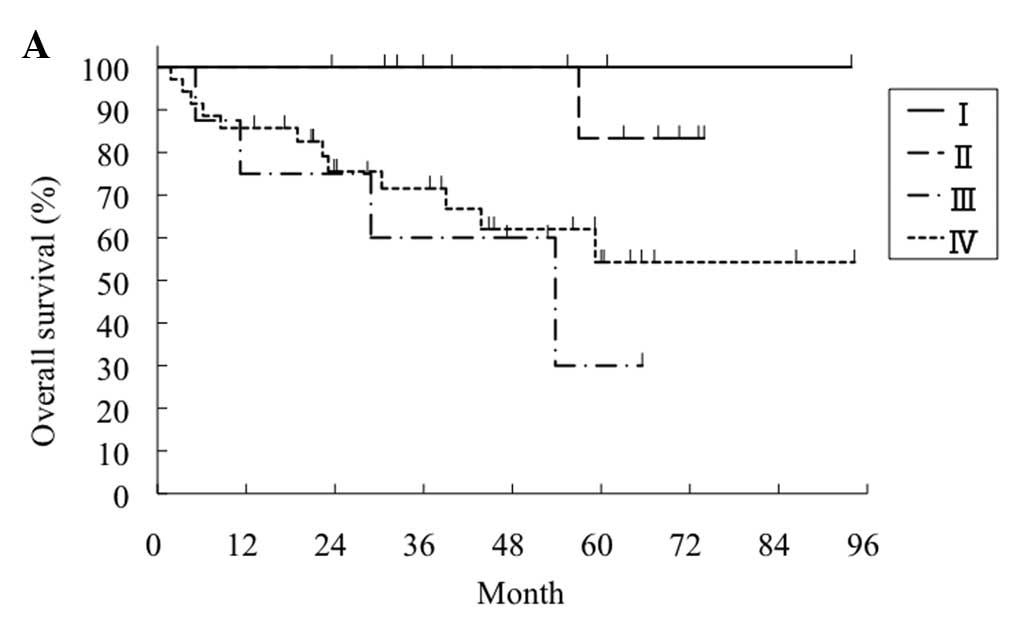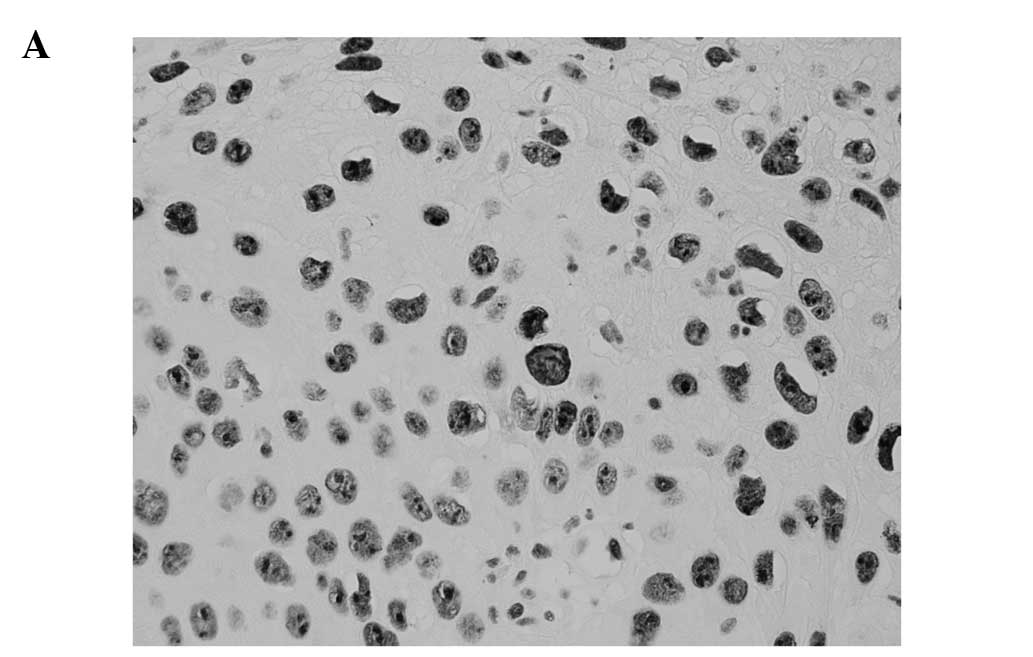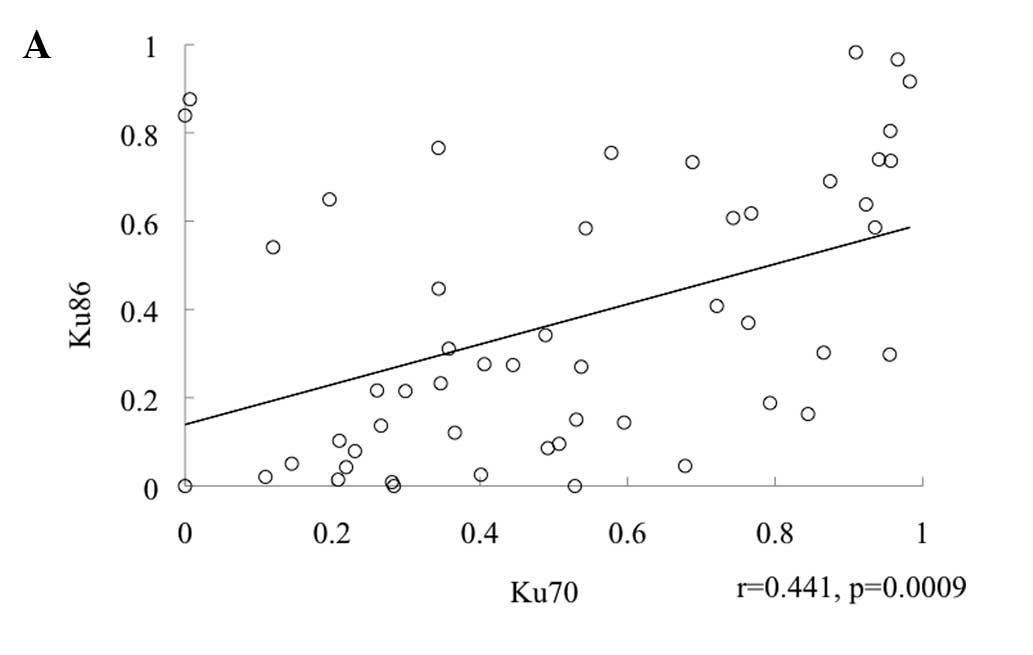Analysis and results of Ku and XRCC4 expression in hypopharyngeal cancer tissues treated with chemoradiotherapy
- Authors:
- Published online on: April 5, 2012 https://doi.org/10.3892/ol.2012.674
- Pages: 151-155
Abstract
Introduction
Hypopharyngeal carcinoma is a difficult carcinoma to treat due to the fact that it is often diagnosed at a late stage and that it has an aggressive natural history. The standard operation is a total pharyngolaryngectomy. This procedure can have a negative impact on the well-being of patients as it involves tracheotomy and loss of natural voice, which may lead to social isolation, loss of employment and depression. Chemoradiotherapy (radiotherapy plus concurrent chemotherapy) has become the standard of care for patients with unresectable squamous cell carcinoma of the head and neck (1) and for organ preservation (2,3).
The repair of various types of DNA damage is critical for cell survival. Of these, DNA double-strand break (DSB) is understood to be one of the most serious forms of damage induced by DNA-damaging agents such as ionizing irradiation (4). Non-homologous end-joining (NHEJ) is a key mechanism of DNA DSB repair (5). In the NHEJ pathway, DSBs are rejoined at an appropriate chromosomal end, either directly or following DNA end processing, and DNA-dependent protein kinase (DNA-PK) is important in DNA DSB repair by NHEJ throughout the cell cycle (6). DNA-PK is a serine/threonine kinase, which is composed of the DNA-PK catalytic subunit (DNA-PKcs) and the heterodimer of Ku70 and Ku86. DNA-PK binds DSBs in DNA, and phosphorylates and activates DNA-binding protein, including XRCC4 and DNA ligase IV, p53 and several transcription factors. Subsequently, ligase IV repairs DNA DSB (7). Therefore, DNA-dependent protein kinase (DNA-PK) is important in DNA DSB repair. The immunohistochemical analysis of proteins involved in DNA DSB repair such as Ku70, Ku86 and XRCC4 may have potential as a predictive assay for tumor radiosensitivity (8,9).
In this study, we investigated the correlation between the expression of proteins involved in DNA DSB and the results of chemoradiotherapy for hypopharyngeal cancers in patients admitted to the Sapporo Medical University. We also examined the expression of Ki-67, a nuclear protein that is expressed in cycling cells.
Patients and methods
Patients
Fifty-seven Japanese patients with previously untreated squamous cell carcinoma of the hypopharynx were treated at the Sapporo Medical University between March 2002 and December 2009.
The patient population consisted of 48 men and 9 women. The mean age was 63 years (range, 33–82). The distribution according to the subsites of the hypopharynx was 48 piriform sinus, 7 postcricoid area and 2 posterior pharyngeal wall. With regard to TNM stage (7th edition), 4 patients had stage I disease, 10 had stage II, 8 had stage III and 35 had stage IV disease (Table I). Most patients (75%) had stage III or IV disease.
Patients with distant metastasis at the first admission were excluded from this study.
This study was approved by the ethics committee of Sapporo University. Patient consent was obtained either from the patient or the patient’s family.
Treatments
In 51 of the 57 patients, chemotherapy was administered concurrently with radiotherapy. Six patients were treated with radiotherapy alone. The chemotherapy consisted of FP (cisplatin plus 5FU) or S-1. FP was used in 39 patients and S-1 in 12 patients. FP consisted of cisplatin 40–60 mg/m2 intravenously and 5FU 400–700 mg/body/day for 4 days by continuous venous infusion. S-1 (50–80 mg/body) was orally administered during periods of radiotherapy.
Radiation was administered using a 4 MV photon linear accelerator. The primary tumor, jugular and retropharyngeal nodes were treated with lateral parallel-opposed photon fields. An appositional anterior field was used to irradiate the supraclavicular and paratracheal nodes. A tumor dose of 50 Gy (25 fractions/5 weeks) was administered to the primary tumor and regional lymph nodes. Doses of 10–20 Gy were usually added to the primary tumor with reduced fields after 50 Gy.
Immunohistochemical staining of various proteins in hypopharyngeal cancer tissues
Formalin-fixed, paraffin-embedded specimens from biopsy were used. Immunohistochemical staining was carried out using methods described in a previous study (10). Anti-Ku70, Ku86 or XRCC4 rabbit polyclonal antisera, which have been described previously (10,11), were used. Ki-67 staining was performed with MIB-1 monoclonal rabbit antibody (Dako, Copenhagen, Denmark) using methods described previously (12). The number of cells that stained positive for Ku70, Ku86, XRCC4 and Ki-67 were determined by scoring 3 microscopic fields of 300 tumor cells each, without prior knowledge of radiosensitivity or treatment outcome, and determining the percentages of cells that were positive for the expression of Ku70, Ku86, XRCC4 and Ki-67.
Statistical analysis
The median follow-up time to the last contact or mortality was 30 months, with a range of 0 to 93 months. The cut-off for analysis was November 2011. Patients alive at the cut-off date had a median follow-up time of 45 months. Overall and disease-free survival were calculated by the Kaplan-Meier method. Differences were analyzed by the log-rank test. A significance level of 0.05 was used throughout. Locoregional recurrence refers to recurrence in the hypopharynx and/or regional lymph nodes.
Results
Overall and disease-free survival rates
The overall 5-year survival rate in patients treated with chemoradiotherapy was 100% in stage I, 83% in stage II, 30% in stage III and 50% in stage IV (Fig. 1A). The difference in the overall 5-year survival between stages I-II and stages III-IV was significant (P=0.02). The 5-year disease-free survival rate in patients treated with chemoradiotherapy was 100% in stage I, 90% in stage II, 64% in stage III, and 50% in stage IV (Fig. 1B). The difference in disease-free survival between stages I-II and stages III-IV was significant (P=0.02).
Treatment results according to stage
Table I shows the treatment results according to stage. Only 3 of 22 patients experienced locoregional recurrence and/or distant metastasis in stages I-III compared to 17 of 35 patients in stage IV. Most patients with distant metastasis also experienced locoregional recurrence, although two patients had distant metastasis alone.
Immunohistochemical staining
The staining of Ku70, Ku86, XRCC4 and Ki-67 was nuclear with none of the normal epithelial cells or malignant cells exhibiting cytoplasmic or membrane immunoreactivity. The staining was diffuse throughout the cell nucleus (Fig. 2).
Analysis of results of immunohistology and survival
The percentage of cells that expressed Ku70, Ku86, XRCC4 and Ki-67 in different tumors was analyzed (Table II).
We examined whether there was a correlation between the expression levels of proteins involved in NHEJ. A significant correlation was found between the percentage of cells expressing Ku70 and Ku86 (r=0.44; P=0.009; Fig. 3A), Ku70 and XRCC4 (r=0.39; P=0.004; Fig. 3B), and Ku86 and XRCC4 (r=0.54; P<0.0001; Fig. 3C).
The mean percentage of cells expressing Ku70 in the local control group was 49% and that in the local failure group was 57%. The mean percentage of cells expressing Ku86 in the local control group was 39% and that in the local failure group was 34%. The mean percentage of cells expressing XRCC4 in the local control group was 76% and that in the local failure group was 79%. The mean percentage of cells expressing Ki-67 in the local control group was 35% and that in the local failure group was 41%.
An analysis of the correlation between the expression of these proteins and locoregional control was performed according to stage. In stages I-III, patients with a lower expression of Ku70 (<35%) tended to have better locoregional control (Table III). In stages I-III, patients with a lower expression of XRCC4 (<78%) tended to have better locoregional control (Table IV). However, this tendency in Ku70 and XRCC4 was not significant due to the small numbers. There was no such tendency in patients with stage IV (Tables III and IV).
Table IIIThe correlation between the expression of Ku70 and locoregional control according to stage. |
Table IVThe correlation between the expression of XRCC4 and locoregional control according to stage. |
We also analyzed the correlation between the expression of Ku70, Ku86, XRCC4 and Ki-67 and distant metastasis. Nine patients experienced distant metastasis. In seven patients the distant metastasis was accompanied by locoregional recurrence but two patients had distant metastasis alone (Table I). In patients with both distant metastasis and locoregional recurrence, there was no apparent correlation between the expression of these proteins and distant metastasis. By contrast, in two patients with distant metastasis alone, one patient had 0% expression of Ku70 and the other had 0% expression of Ku86 (Fig. 3A). There were four patients with 0% expression of Ku70 or Ku86. None of the four patients experienced locoregional recurrence. Two patients developed distant metastasis.
Discussion
The estimates of overall and disease-free survival at 3 years in all patients were 78 and 63%, respectively (Fig. 1A and B). These treatment results were comparable with other studies using chemoradiotherapy (13,14).
We examined whether there was a correlation between the expressions of proteins involved in NHEJ. A significant correlation was found between the percentage of cells expressing Ku70 and Ku86 (Fig. 3A), Ku70 and XRCC4 (Fig. 3B), and Ku86 and XRCC4 (Fig. 3C). The results of Ku70 and Ku86 were in agreement with our previous results, demonstrating that the expression of Ku70 and Ku86 paralleled each other in breast cancer tissues (15). These results indicated that there was a concerted expression of Ku70 and Ku86 in breast cancer tissues. Hosoi et al reported that Ku70 and Ku86 have consensus Sp1 recognition elements in their promoter region and that Sp1 may influence the concerted expression of Ku70 and Ku86 (16). To the best of our knowledge, the correlation of the expression of XRCC4 with that of Ku70 or Ku86 is a new finding. However, the mechanism of the concerted expression of these proteins remains to be determined.
Patients with a lower expression of Ku70 or XRCC4 tended to have better locoregional control in stages I-III (Table III). Komuro et al reported results of 96 patients with advanced rectal carcinoma treated with preoperative radiotherapy (8). The lower expression of Ku70 or Ku86 in preradiation biopsy specimens of tumor samples was correlated with better objective responses, suggesting that low expression of Ku70 or Ku86 may be correlated with high radiosensitivity.
There was no such correlation between the expression of Ku70 or XRCC4 and locoregional control in patients with stage IV (Tables II and III). Patients with stage IV had a large primary tumor and/or large lymph node metastases. In such a situation, the large number of tumor cells and hypoxic tumor cells may affect radiocurability and obscure the effect of Ku70 or XRCC4 expression.
Ki-67 is a nuclear protein that is expressed in cycling cells. For patients treated with radiotherapy, the tumors with a high Ki-67 labeling index demonstrated good local control in squamous cell carcinomas of the head and neck (17), esophageal cancer (18) and uterine cervical cancer (19). However, no such correlation was found between the Ki-67 labeling index and locoregional control of hypopharyngeal cancer treated with chemoradiotherapy in our results. This observation indicated that chemoradiotherapy may be effective for tumors that included non-cycling cells.
There were two patients with distant metastasis alone, one of whom had 0% expression of Ku70 and the other a 0% expression of Ku86. There were four patients with 0% expression of Ku70 or Ku86 (Fig. 2A). None of the four patients experienced locoregional recurrence but two developed distant metastasis alone. These results may be associated with our previous results which demonstrated that breast cancer cells with a lower expression of Ku70 or Ku86 had aggressive cancer phenotypes such as a higher nuclear grade and positive axillary lymph node metastasis (15). Genes involved in DNA DSB repair are involved in the maintenance of genomic stability (20). We previously demonstrated that DNA-PK activity is associated with chromosomal instability (21). An absence of Ku70 or Ku86 expression indicates low DNA-PK activity. Such low DNA-PK activity resulted in the genetic alteration of cancer cells, leading to higher tendency of distant metastasis.
In conclusion, patients with a lower expression of Ku70 or XRCC4 tended to have better locoregional control in stages I-III, but there was no such tendency in patients with stage IV. In two patients with distant metastasis alone, one patient had 0% expression of Ku70 and the other had 0% expression of Ku86. This finding suggests that proteins involved in NHEJ may have an impact on the treatment results of chemoradiotherapy in hypopharyngeal cancer.
Acknowledgements
The study was supported in part by a Grant-in-Aid for Scientific Research from the Ministry of Education, Culture, Sports, Science and Technology, Japan and by a grant from the Program for Developing the Supporting System for Upgrading Education and Research in Sapporo Medical University.
References
|
Adelstein DJ, Li Y, Adams GL, et al: An intergroup study phase III comparison of standard radiation therapy and two schedules of concurrent chemoradiotherapy in patients with unresectable squamous cell head and neck cancer. J Clin Oncol. 21:92–98. 2003. View Article : Google Scholar | |
|
Denis F, Garaud P, Bardet E, et al: Final results of the 94-01 French Head and Neck Oncology and Radiotherapy Group randomized trial comparing radiotherapy alone with concomitant radiochemotherapy in advanced-stage oropharynx carcinoma. J Clin Oncol. 22:69–76. 2004. View Article : Google Scholar | |
|
Forastiere AA, Goepfert H, Maor M, et al: Concurrent chemotherapy and radiotherapy for organ preservation in advanced laryngeal cancer. N Engl J Med. 349:2091–2098. 2003. View Article : Google Scholar : PubMed/NCBI | |
|
Hall EJ: DNA strand breaks and chromosomal aberrations. Radiobiology for the Radiologist. Hall EJ and Giaccia AM: 6th edition. Lippincott Williams & Wilkins; Philadelphia: pp. 16–29. 2006 | |
|
Polo SE and Jackson SP: Dynamics of DNA damage response proteins at DNA breaks: a focus on protein modification. Gene Dev. 25:409–433. 2011. View Article : Google Scholar : PubMed/NCBI | |
|
Lees-Miller SP: The DNA-dependent protein kinase, DNA-PK: 10 years and no ends in sight. Biochem Cell Biol. 74:503–512. 1996.PubMed/NCBI | |
|
Jeggo PA: Identification of genes involved in repair of DNA double-strand breaks in mammalian cells. Radiat Res. 150:S80–S91. 1998. View Article : Google Scholar : PubMed/NCBI | |
|
Komuro Y, Watanabe T, Hosoi Y, et al: The expression pattern of Ku correlates with tumor radiosensitivity and disease free survival in patients with rectal carcinoma. Cancer. 95:1199–1205. 2002. View Article : Google Scholar : PubMed/NCBI | |
|
Zhao HJ, Hosoi Y, Miyachi H, et al: DNA-dependent protein kinase activity correlates with Ku70 expression and radiation sensitivity in esophageal cancer cell lines. Clin Cancer Res. 6:1073–1078. 2000.PubMed/NCBI | |
|
Sakata K, Matsumoto Y, Tauchi H, et al: Expression of genes involved in repair of DNA double-strand breaks in normal and tumor tissues. Int J Radiat Oncol Biol Phys. 49:161–167. 2001. View Article : Google Scholar : PubMed/NCBI | |
|
Kamdar RP and Matsumoto Y: Radiation-induced XRCC4 association with chromatin DNA analyzed by biochemical fractionation. J Radiat Res. 51:303–313. 2010. View Article : Google Scholar : PubMed/NCBI | |
|
Sakata K, Someya M, Nagakura H, et al: Brachytherapy for oral tongue cancer: an analysis of treatment results with various biological markers. Jpn J Clin Oncol. 38:402–407. 2008. View Article : Google Scholar : PubMed/NCBI | |
|
Pointreau Y, Garaud P, Chapet S, et al: Randomized trial of induction chemotherapy with cisplatin and 5-fluorouracil with or without docetaxel for larynx preservation. J Natl Cancer Inst. 101:498–506. 2009. View Article : Google Scholar | |
|
Posner MR, Hershock DM, Blajman CR, et al: Cisplatin and fluorouracil alone or with docetaxel in head and neck cancer. New Engl J Med. 25:1705–1715. 2007. View Article : Google Scholar : PubMed/NCBI | |
|
Someya M, Sakata K, Matsumoto Y, Satoh M, Narimatsu H and Hareyama M: Immunohistochemical analysis of Ku70/86 expression of breast cancer tissues. Oncol Rep. 18:1483–1487. 2007.PubMed/NCBI | |
|
Hosoi Y, Watanabe T, Nakagawa K, et al: Up-regulation of DNA-dependent protein kinase activity and Sp1 in colorectal cancer. Int J Oncol. 25:461–468. 2004.PubMed/NCBI | |
|
Raybaud-Diogene H, Fortin A, Morency R, Roy J, Monteil RA and Tetu B: Markers of radioresistance in squamous cell carcinomas of the head and neck: a clinicopathologic and immunohistochemical study. J Clin Oncol. 15:1030–1038. 1997.PubMed/NCBI | |
|
Okuno Y, Nishimura Y, Kashu I, Ono K and Hiraoka M: Prognostic values of proliferating cell nuclear antigen (PCNA) and Ki-67 for radiotherapy of oesophageal squamous cell carcinomas. Br J Cancer. 80:387–395. 1999. View Article : Google Scholar : PubMed/NCBI | |
|
Nakano T and Oka K: Differential values of Ki-67 index and mitotic index of proliferating cell population. An assessment of cell cycle and prognosis in radiation therapy for cervical cancer. Cancer. 72:2401–2408. 1993. View Article : Google Scholar : PubMed/NCBI | |
|
Burma S, Chen BPC and Chen DJ: Role of non-homologous end joining (NHEJ) in maintaining genomic integrity. DNA Repair. 5:1042–1048. 2006. View Article : Google Scholar : PubMed/NCBI | |
|
Someya M, Sakata K, Matsumoto Y, et al: The association of DNA-dependent protein kinase activity with chromosomal instability and risk of cancer. Carcinogenesis. 27:117–122. 2006. View Article : Google Scholar : PubMed/NCBI |












